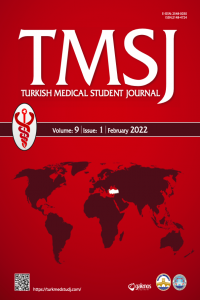EVALUATION OF THORACOLUMBAR INJURIES IN TRAKYA UNIVERSITY SCHOOL OF MEDICINE ACCORDING TO AOSPINE CLASSIFICATION SYSTEM
EVALUATION OF THORACOLUMBAR INJURIES IN TRAKYA UNIVERSITY SCHOOL OF MEDICINE ACCORDING TO AOSPINE CLASSIFICATION SYSTEM
Classification, spine, injury,
___
- 1. Mohamadi A, Googanian A, Ahmadi A et al. Comparison of surgical or nonsurgical treatment outcomes in patients with thoracolumbar fracture with Score 4 of TLICS: a randomized, single-blind, and single-central clinical trial. Medicine (Baltimore) 2018;97(6):e9842. 2. Kim BG, Dan JM, Shin DE. Treatment of thoracolumbar facture. Asian Spine Journal 2015;9(1):133-46. 3. Azam MQ, Sadat-Ali M. The concept of evolution of thoracolumbar fracture classifications helps in surgical decisions. Asian Spine J 2015;9(6):984–94. 4. Denis F. The three column spine and its significance in the classification of acute thoracolumbar spinal injuries. Spine 1983;8(8):817- 31. 5. Gomleksiz C. Thoracolumbar fractures: a review of classifications and surgical methods. Journal of Spine 2015;04:250. 6. Vaccaro AR, Oner C, Kepler CK et al. AOSpine thoracolumbar spine injury classification system: fracture description, neurological status, and key modifiers. Spine 2013;38(23):2028-37. 7. Vaccaro AR, Schroeder GD, Kepler CK et al. The surgical algorithm for the AOSpine thoracolumbar spine injury classification system. Eur Spine J 2016;25(4):1087-94. 8. Kepler CK, Vaccaro AR, Koerner JD et al. Reliability analysis of the AOSpine thoracolumbar spine injury classification system by a worldwide group of naïve spinal surgeons. European Spine Journal 2015;25(4):1082–86. 9. Cheng J, Liu P, Sun D et al. Reliability and reproducibility analysis of the AOSpine thoracolumbar spine injury classification system by Chinese spinal surgeons. European Spine Journal 2016;26(5):1477- 82. 10. Azimi P, Mohammadi HR, Azhari S et al. The AOSpine thoracolumbar spine injury classification system: a reliability and agreement study. Asian J Neurosurg 2015;10:282-5. 11. Abedi A, Mokkink LB, Zadegan SA et al. Reliability and validity of the AOSpine thoracolumbar injury classification system: a systematic review. Global Spine J 2019;9(2):231–42. 12. Reinhold M, Audigé L, Schnake KJ et al. AO spine injury classification system: a revision proposal for the thoracic and lumbar spine. Eur Spine J. 2013;22(10):2184–201. 13. Dodwad SN, Dodwad SJ, Wisneski R et al. Retrospective analysis of thoracolumbar junction injuries using the thoracolumbar injury severity and classification score, American spinal injury association class, injury severity score, age, sex and length of hospitalization. Journal of Spinal Disorders and Techniques 2015;28(7):410-6. 14. Schousboe JT. Epidemiology of vertebral fractures. Journal of Clinical Densitometry 2016;19(1):8-22. 15. Sidon E, Stein M, Ramalingam G et al. Gender differences in spinal injuries: causes and location of injury. Journal of Women’s Health 2018;27(7):946-51. 16. Hernlund E, Svedbom A, Ivergård M et al. Osteoporosis in the European Union: medical management, epidemiology and economic burden. A report prepared in collaboration with the International Osteoporosis Foundation (IOF) and the European Federation of Pharmaceutical Industry Associations (EFPIA). Archives of Osteoporosis 2013;8:136. 17. Hoy D, Brooks P, Blyth F et al. The epidemiology of low back pain. Best Pract Res Clin Rheumatol 2010;24(6):769–81. 18. Rajasekaran S, Vaccaro AR, Kanna RM et al. The value of CT and MRI in the classification and surgical decision-making among spine surgeons in thoracolumbar spinal injuries. Eur Spine J 2017;26(5):1463–9. 19. Kepler CK, Vaccaro AR, Schroeder GD et al. The thoracolumbar AOSpine injury score. Global Spine Journal 2016;6(4):329-34. 20. Jordan KM, Cooper C. Epidemiology of osteoporosis. Best Practice & Research Clinical Rheumatology 2002;16(5):795-806. 21. Melton III LJ, Thamer M, Ray NF et al. Fractures attributable to osteoporosis: report from the National Osteoporosis Foundation. Journal of Bone and Mineral Research 1997;12(1):16-23.
- ISSN: 2148-4724
- Başlangıç: 2014
- Yayıncı: Trakya Üniversitesi
CLINICOPATHOLOGICAL FEATURES OF MYELOID SARCOMA PATIENTS FROM A SINGLE CENTER EXPERIENCE
Fatih Erkan AKAY, Hakkı Onur KIRKIZLAR, Elif MERCAN, Fulya ÖZ PUYAN
Irmak İrem ÖZYİĞİT, Alperen Taha CERTEL, Begüm SÖYLEYİCİ, Sezgin KEHAYA
ARROW CAUSE OF ANGINA PECTORIS: SINGLE CORONARY ARTERY ANOMALY IN ELDERLY PATIENT
CANNABINOID RECEPTORS ARE NOT INVOLVED IN ANTINOCICEPTION INDUCED BY SYSTEMIC DICLOFENAC IN MICE
Beiza CHATZİSALİ, Tolga GAŞ, Hilmi KILGIN, Kübra Duvan AYDEMİR, Dilşat ERÜMİT, Ruhan Deniz TOPUZ, Ahmet ULUGÖL
Gonca AKSU, Sercan SARAN, Mahmut Sami OFLAZ, Mert ÇİFTDEMİR
IL-17/TNF-α BISPECIFIC ANTIBODIES AS NEW THERAPEUTIC APPROACH TO RHEUMATOID ARTHRITIS
THE IMPACT OF OPEN INGUINAL HERNIA MESH REPAIR ON QUALITY OF LIFE
Elif CENGİZ, Toprak Kağan AKSU, Hilal Sena ÇİFCİBAŞI, Tuğrul DEMİREL
